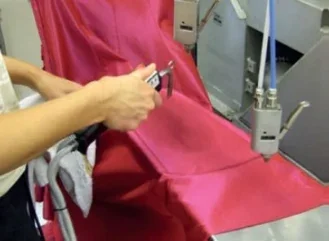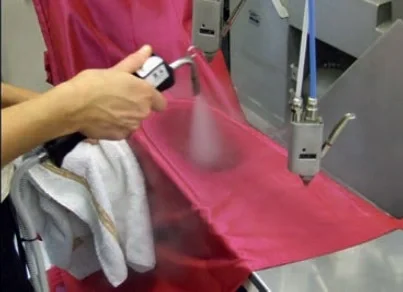
Cleaners and experts vary considerably in their views as to what this instruction actually means, what is the definition of spot cleaning, and what are the parameters in terms of localised stain treatments? Unlike the UK, care labelling in the USA is mandatory but it can be in the form of symbols or just words or a combination of both and ‘Spot Clean Only’ is considered to be a proper care label. However, the DLI (Dry Cleaning & Laundry Institute) has considered it to be for the guidance of the customer and the buyer beware.
In Europe ‘Spot Clean Only’ is not a recognised care label. An important point for cleaners to consider is that in the UK, if dyes and prints are not fast to cold water the item would probably be considered not fit for purpose as any accidental splash during use could make the item unwearable, in which case the customer may be able to make a claim against the retailer under the Consumer Rights Act 2015. I have successfully supported a cleaner in just such a case involving a designer dress.
The instruction ‘Spot Clean Only’ should generally be taken to mean that the garment should not be subjected to any form of total immersion process, wet or dry, and that stain removal procedures must be confined to only the stained areas of the garment. In other words, the item should not be cleaned in its entirety including wetting out on a coat hanger and drip drying.

Sensible precautions
For the cleaner who is considering whether to accept a garment I think it is important to recognise that such items are unlikely to have been subjected to any recognised testing standards and therefore the response of dyes and trims to either waterbased or solvent-based localised stain treatments could well be unpredictable. Therefore, it is particularly important to establish the state of dye fastness before proceeding. Because of the infinitely variable nature of staining both in terms of stain type, the difficulty of removing some stains, e.g. curry, and particularly the extent and size of the stained area, the cleaner will need to consider carefully if the stains are manageable on the spotting table; if they are not refer the customer back to the retailer or agree owners risk if a total immersion procedure is required, but reject items with large oil based stains. Bear in mind that the larger the stained area the more difficult it may become to level up after removing the stains and that there is likely to be an increasing risk that you could be forced into wetting out the whole garment. Finally, if you agree owners risk with the customer to go ahead with a water based procedure; for simple stains such as water splash, try wetting out the garment on a coat hanger using a solution of cold water containing a few drops of washing up liquid – this treatment is often very effective on extensive water based staining. However, in this case, it is important to state clearly in writing the risk involved which might be shrinkage and distortion and/or problems associated with dye fastness or trims. From my point of view, I would never accept a garment at ‘Owner’s Risk’ unless I believed there to be at least a 70% chance of a good outcome. In the event of failure it is inevitable that the customer will be disappointed and this is may reflect adversely on the cleaner.






